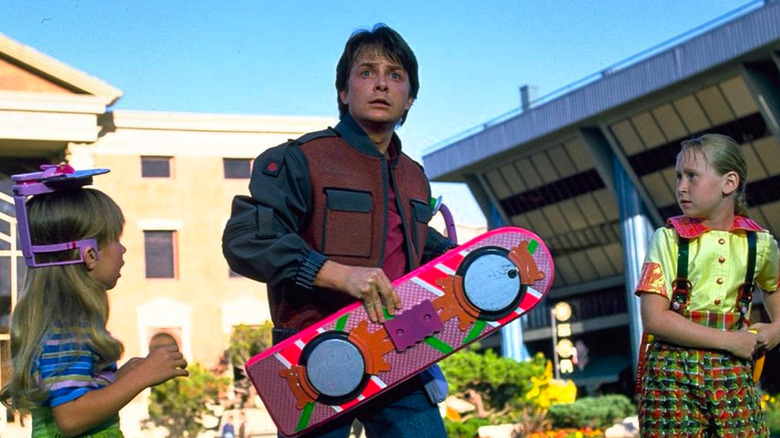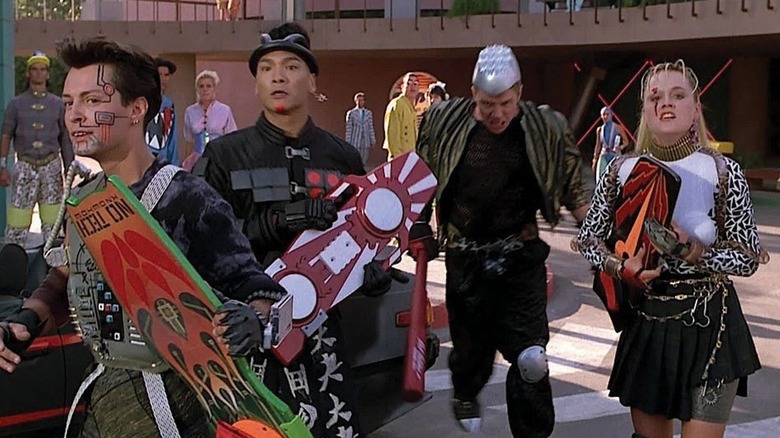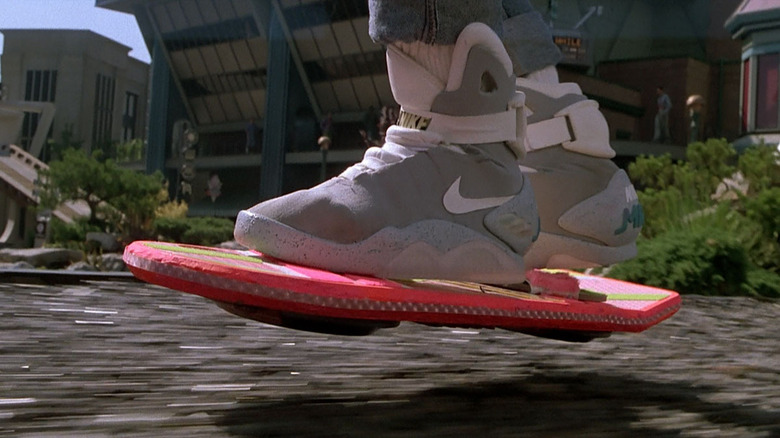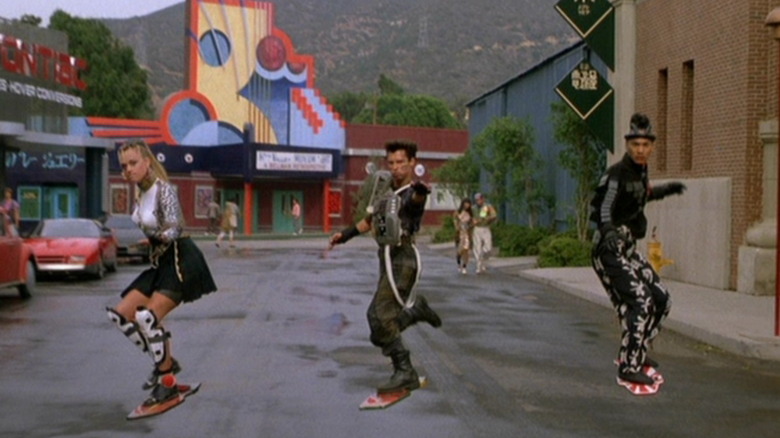A Back To The Future Hoverboard Stunt Gone Wrong Almost Killed A Stuntwoman
We may receive a commission on purchases made from links.
The hoverboard scenes in "Back to the Future Part II" were astonishing at the time, and director Robert Zemeckis used a complex combination of techniques to film them. When filming from low angles, Zemeckis suspended his actors from above. He used cranes and pulleys, green-screen effects, and some dedicated stunt people to achieve the visuals.
In a notable sequence, Marty (Michael J. Fox) becomes stranded on a hoverboard over a pond; it seems hoverboards cannot operate over water. A bully, Griff (Thomas F. Wilson), takes the opportunity to attack Marty on his own, high-powered hoverboard, with three of his punk friends towed behind on cables. Griff flies toward Marty, swings a baseball bat, misses, and flies wildly out of control. He and his three sidekicks keep on soaring and crash through the plate glass window of a clock tower.
In order to achieve this stunt — detailed in Caseen Gaines' 2015 book "We Don't Need Roads: The Making of the Back to the Future Trilogy" – stunt performers actually had to swing through the air on cables, crash through a real (safety glass) window and fall onto an airbag once inside. Unfortunately, it seems that the stunt was more dangerous than anticipated.
The mechanics of the hoverboard stunt
The stunt was, of course, vetted and tested. Robert Zemeckis and the "Back to the Future Part II" stunt team constructed an elaborate device that would swing the hoverboard-riding villains into the glass window, and then, once effectively crashed, a member of the special effects team would slam a button, cutting their cables. At the same instant, a quick-inflate air bag would puff up on the ground below, and the stunt performers would fall onto it, presumably safely. Prior to testing it with real people, the stunt team set it up, using human-sized sandbags as their crash test dummies.
The tests didn't go terribly well. In the first test, one of the sandbags missed the quick-inflate airbag and landed directly on the floor. In the second test, two of them did. Still eager to get it to work correctly, the filmmakers tried again with actual stunt people. It seems that even with performers able to more carefully aim, it still ended poorly. Two of the stunt performers landed on an uninflated airbag and injured themselves. Eventually, a successful run was completed. The on-camera stunt performers were assured that it would go well when then they actually tried, but stuntwoman Lisa McCullough was reluctant. Stepping in for McCullough was Cheryl Wheeler.
Already not 100% safe, the stunt crew made a last-minute alteration, a dangerous move indeed. They replaced the ordinary breakaway glass with a softer, candy glass that would be safer for anyone standing on the ground below, as it doesn't break into sharp edges. Additionally, the filmmakers decided just then that one of the hoverboards should have sparks shooting out of the back, requiring the addition of a small rocket.
All the changes were what endangered Cheryl Wheeler.
Every decision made the hoverboard stunt more dangerous
Cheryl Wheeler recalled the day of the shoot, a day when she would end up in a hospital. She asked again and again if the marks were exactly where they were before, and if everyone was set up to the correct specifications. The stunt coordinator, Walter Scott, thought that Wheeler's questions about the stunt were a sign that she was getting "cold feet," and he said that he was going to replace Wheeler with another stunt performer. She said to Scott that she was "not getting cold feet at all. I just want to understand. I was in hair and makeup and haven't been out there to see the stunt setup."
Wheeler, Gaines' book points out, had only been a professional stuntwoman for a few years — her first high-end gig was in 1985 — and didn't feel she was in a position to delay an enormous studio production because of vague misgivings about a stunt setup. She agreed to do the stunt, even as new complications kept arising in the countdown up to her launch. The candy glass, she late found out, was not as transparent as the breakaway kind. This meant that the person manning the cable-cutting button, a man named Greg Tippie, wouldn't necessarily be able to see when the stunt performers were all the way through the window. Additionally, the newly added rocket added smoke to the scene, further blocking Tippie's view.
Tippie also had the unwise idea to move inside the building to watch the stunt, rather than standing outside as he did before. The man in charge of cutting Wheeler's cable at a very precise moment was in a position where he wouldn't be able to see much of anything.
How Cheryl Wheeler almost died on Back to the Future Part II
Cheryl Wheeler recalls the stunt failing almost immediately. When she and her co-stars were hoisted in the air, the cabled swung wildly in the wrong direction. Rather than heading straight for the window, Wheeler began swinging far out to the right, directly toward a massive pillar next to the window. She remembers thinking repeatedly "I'm going to hit this pillar." Pinwheeling with her stomach parallel to the ground, that's exactly what happened. The stunt performer smacked incredibly hard into an exterior pillar while her co-stars crashed through the window.
As it happens, Wheeler was padded up pretty heavily, and slamming into the pillar at high speeds actually didn't hurt. She was rattled, but uninjured. The stunt failed, and she crashed, but the crisis had been averted. It's what happened next that actually hurt.
Because Tippie was inside the building, and because he couldn't see that Wheeler hadn't made it inside, decided to cut everyone's cables as planned. Some of the stunt performers landed on the inflated airbag. Wheeler, still dangling outside, plummeted, face-first onto the concrete below from thirty feet up. She essentially belly-flopped onto a sidewalk. She bled a lot and some of the crew thought briefly that she had died. According to the August 1993 issue of Black Belt Magazine, Wheeler required reconstructive surgery following the event, as she shattered her face and right wrist.
Wheeler would recover, luckily. She continued to work and would become a celebrated and award-winning stunt performer, performing in "Die Hard 2," "Demolition Man," "Charlie's Angels," and the "Lethal Weapon" movies. She would also continue a lucrative martial arts career.
Wheeler tragically died in 2020 after she and her husband got into a shootout with her ex-husband. She was 59.



